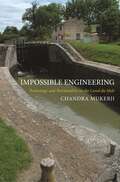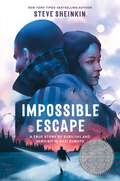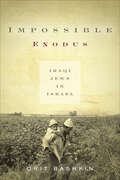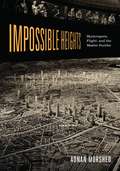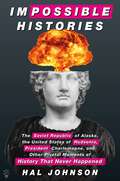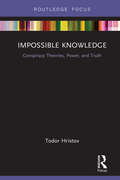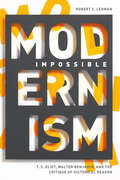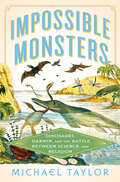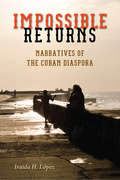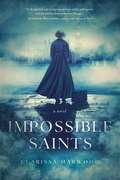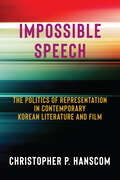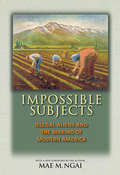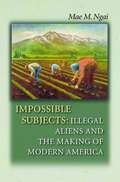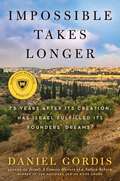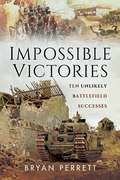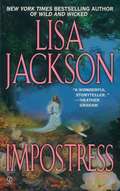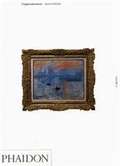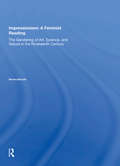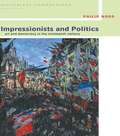- Table View
- List View
Impossible Engineering: Technology and Territoriality on the Canal du Midi (Princeton Studies in Cultural Sociology)
by Chandra MukerjiThe Canal du Midi, which threads through southwestern France and links the Atlantic to the Mediterranean, was an astonishing feat of seventeenth-century engineering--in fact, it was technically impossible according to the standards of its day. Impossible Engineering takes an insightful and entertaining look at the mystery of its success as well as the canal's surprising political significance. The waterway was a marvel that connected modern state power to human control of nature just as surely as it linked the ocean to the sea. The Canal du Midi is typically characterized as the achievement of Pierre-Paul Riquet, a tax farmer and entrepreneur for the canal. Yet Chandra Mukerji argues that it was a product of collective intelligence, depending on peasant women and artisans--unrecognized heirs to Roman traditions of engineering--who came to labor on the waterway in collaboration with military and academic supervisors. Ironically, while Louis XIV and his treasury minister Jean-Baptiste Colbert used propaganda to present France as a new Rome, the Canal du Midi was being constructed with unrecognized classical methods. Still, the result was politically potent. As Mukerji shows, the project took land and power from local nobles, using water itself as a silent agent of the state to disrupt traditions of local life that had served regional elites.Impossible Engineering opens a surprising window into the world of seventeenth-century France and illuminates a singular work of engineering undertaken to empower the state through technical conquest of nature.
Impossible Escape: A True Story of Survival and Heroism in Nazi Europe
by Steve Sheinkinrom three-time National Book Award finalist and Newbery Honor author Steve Sheinkin, a true story of two Jewish teenagers racing against time during the Holocaust—one in hiding in Hungary, and the other in Auschwitz, plotting escape. <p><p> It is 1944. A teenager named Rudolf (Rudi) Vrba has made up his mind. After barely surviving nearly two years in the Auschwitz concentration camp in Poland, he knows he must escape. Even if death is more likely. <p><p> Rudi has learned the terrible secret hidden behind the heavily guarded fences of concentration camps across Nazi-occupied Europe: the methodical mass killing of Jewish prisoners. As trains full of people arrive daily, Rudi knows that the murders won’t stop until he reveals the truth to the world—and that each day that passes means more lives are lost. <p><p> Lives like Rudi’s schoolmate Gerta Sidonová. Gerta’s family fled from Slovakia to Hungary, where they live under assumed names to hide their Jewish identity. But Hungary is beginning to cave under pressure from German Nazis. Her chances of survival become slimmer by the day. <p><p> The clock is ticking. As Gerta inches closer to capture, Rudi and his friend Alfred Wetzler begin their crucial steps towards an impossible escape. <p><p> This is the true story of one of the most famous whistleblowers in the world, and how his death-defying escape helped save over 100,000 lives.
Impossible Exodus: Iraqi Jews in Israel (Stanford Studies In Middle Eastern And Islamic Societies And Cultures Ser.)
by Orit BashkinBetween 1949 and 1951, 123,000 Iraqi Jews immigrated to the newly established Israeli state. Lacking the resources to absorb them all, the Israeli government resettled them in maabarot, or transit camps, relegating them to poverty. In the tents and shacks of the camps, their living conditions were squalid and unsanitary. Basic necessities like water were in short supply, when they were available at all. Rather than returning to a homeland as native sons, Iraqi Jews were newcomers in a foreign place. Impossible Exodus tells the story of these Iraqi Jews' first decades in Israel. Faced with ill treatment and discrimination from state officials, Iraqi Jews resisted: they joined Israeli political parties, demonstrated in the streets, and fought for the education of their children, leading a civil rights struggle whose legacy continues to influence contemporary debates in Israel. Orit Bashkin sheds light on their everyday lives and their determination in a new country, uncovering their long, painful transformation from Iraqi to Israeli. In doing so, she shares the resilience and humanity of a community whose story has yet to be told.
Impossible Heights: Skyscrapers, Flight, and the Master Builder
by Adnan MorshedThe advent of the airplane and skyscraper in 1920s and &‘30s America offered the population an entirely new way to look at the world: from above. The captivating image of an airplane flying over the rising metropolis led many Americans to believe a new civilization had dawned. In Impossible Heights, Adnan Morshed examines the aesthetics that emerged from this valorization of heights and their impact on the built environment.The lofty vantage point from the sky ushered in a modernist impulse to cleanse crowded twentieth-century cities in anticipation of an ideal world of tomorrow. Inspired by great new heights, American architects became central to this endeavor and were regarded as heroic aviators. Combining close readings of a broad range of archival sources, Morshed offers new interpretations of works such as Hugh Ferriss&’s Metropolis drawings, Buckminster Fuller&’s Dymaxion houses, and Norman Bel Geddes&’s Futurama exhibit at the 1939 New York World&’s Fair. Transformed by the populist imagination into &“master builders,&” these designers helped produce a new form of visuality: the aesthetics of ascension.By demonstrating how aerial movement and height intersect with popular &“superman&” discourses of the time, Morshed reveals the relationship between architecture, art, science, and interwar pop culture. Featuring a marvelous array of never before published illustrations, this richly textured study of utopian imaginings illustrates America&’s propulsion into a new cultural consciousness.
Impossible Histories: The Soviet Republic of Alaska, the United States of Hudsonia, President Charlemagne, and Other Pivotal Moments of History That Never Happened
by Hal JohnsonAcross 1400 years and six continents (sorry, Australia), Impossible Histories examines pivotal moments in history from both sides—what happened and what would have happened had things gone differently. The results are by turns strange, hilarious, tragic…and always fascinating.Imagine a world in which...- Hitler builds a thousand-year Reich- Columbus gets driven from the Americas by mounted knights- Robespierre decapitates Caesar Augustus- The Inca Empire has an air force- Jimmy Carter presses the ButtonThese brave new worlds are merely our own, familiar world—if something small had happened differently. We're all one elephant away from peace in the Middle East, one knife thrust away from nuclear Armageddon. This book examines twenty pivotal moments in history, asks what if?...,and drags the answers kicking and screaming into the light. History--factual and counterfactual has never been so entertaining.A whirlwind ride through history as it never happened--but could have.
Impossible Knowledge: Conspiracy Theories, Power, and Truth (Conspiracy Theories)
by Todor HristovConspiracy theorists claim impossible knowledge, such as knowledge of the doings of a secret world government. Yet they accept this impossible knowledge as truth. In effect, conspiracy theories detach truth from knowledge. Knowledge without power is powerless. And the impossible knowledge claimed by conspiracy theorists is rigorously excluded from the regimes of truth and power – that is not even wrong. Yet conspiratorial knowledge is potent enough to be studied by researchers and recognized as a risk by experts and authorities. Therefore, in order to understand conspiracy theories, we need to think of truth beyond knowledge and power. That is impossible for any scientific discipline because it takes for granted that truth comes from knowledge and that truth is powerful enough to destroy the legitimacy of any authority that would dare to conceal or manipulate it. Since science is unable to make sense of conspiracy theories, it treats conspiracy theorists as individuals who fail to make sense, and it explains their persistent nonsense by some cognitive, behavioral, or social dysfunction. Fortunately, critical theory has developed tools able to conceive of truth beyond knowledge and power, and hence to make sense of conspiracy theories. This book organizes them into a toolbox which will enable students and researchers to analyze conspiracy theories as practices of the self geared at self-empowerment, a sort of political self-help.
Impossible Modernism: T. S. Eliot, Walter Benjamin, and the Critique of Historical Reason
by Robert LehmanImpossible Modernism reads the writings of German philosopher and critic Walter Benjamin (1892-1940) and Anglo-American poet and critic T. S. Eliot (1888-1965) to examine the relationship between literary and historical form during the modernist period. It focuses particularly on how they both resisted the forms of narration established by nineteenth-century academic historians and turned instead to traditional literary devices--lyric, satire, anecdote, and allegory--to reimagine the forms that historical representation might take. Tracing the fraught relationship between poetry and history back to Aristotle's Poetics and forward to Nietzsche's Untimely Meditations, Robert S. Lehman establishes the coordinates of the intellectual-historical problem that Eliot and Benjamin inherited and offers an analysis of how they grappled with this legacy in their major works.
Impossible Monsters: Dinosaurs, Darwin, and the Battle Between Science and Religion
by Michael Taylor“Vivid with a Mesozoic bestiary” (Tom Holland), this on-the-ground, page-turning narrative weaves together the chance discovery of dinosaurs and the rise of the secular age. When the twelve-year-old daughter of a British carpenter pulled some strange-looking bones from the country’s southern shoreline in 1811, few people dared to question that the Bible told the accurate history of the world. But Mary Anning had in fact discovered the “first” ichthyosaur, and over the next seventy-five years—as the science of paleontology developed, as Charles Darwin posited radical new theories of evolutionary biology, and as scholars began to identify the internal inconsistencies of the Scriptures—everything changed. Beginning with the archbishop who dated the creation of the world to 6 p.m. on October 22, 4004 BC, and told through the lives of the nineteenth-century men and women who found and argued about these seemingly impossible, history-rewriting fossils, Impossible Monsters reveals the central role of dinosaurs and their discovery in toppling traditional religious authority, and in changing perceptions about the Bible, history, and mankind’s place in the world.
Impossible Returns: Narratives of the Cuban Diaspora
by Iraida LopezIn this one-of-a-kind volume, Iraida López explores various narratives of return by those who left Cuba as children or adolescents. Including memoirs, semi-autobiographical fiction, and visual arts, many of these accounts feature a physical arrival on the island while others depict a metaphorical or vicarious experience by means of fictional characters or childhood reminiscences. As two-way migration increases in the post-Cold War period, many of these narratives put to the test the boundaries of national identity. Through a critical reading of works by Cuban American artists and writers like María Brito, Ruth Behar, Carlos Eire, Cristina García, Ana Mendieta, Gustavo Pérez Firmat, Ernesto Pujol, Achy Obejas, and Ana Menéndez, López highlights the affective ties as well as the tensions underlying the relationship between returning subjects and their native country. Impossible Returns also looks at how Cubans still living on the island depict returning émigrés in their own narratives, addressing works by Jesús Díaz, Humberto Solás, Carlos Acosta, Nancy Alonso, Leonardo Padura, and others. Blurring the lines between disciplines and geographic borders, this book underscores the centrality of Cuba for its diaspora and bears implications for other countries with widespread populations in exile.
Impossible Saints: A Novel
by Clarissa HarwoodSet in England in 1907, Impossible Saints is a novel that burns as brightly as the suffrage movement it depicts, with the emotional resonance of Tracy Chevalier and Jennifer Robson. Escaping the constraints of life as a village schoolmistress, Lilia Brooke bursts into London and into Paul Harris’s orderly life, shattering his belief that women are gentle creatures who need protection. Lilia wants to change women’s lives by advocating for the vote, free unions, and contraception. Paul, an Anglican priest, has a big ambition of his own: to become the youngest dean of St. John’s Cathedral. Lilia doesn’t believe in God, but she’s attracted to Paul’s intellect, ethics, and dazzling smile. As Lilia finds her calling in the militant Women’s Social and Political Union, Paul is increasingly driven to rise in the church. They can’t deny their attraction, but they know they don’t belong in each other’s worlds. Lilia would rather destroy property and serve time in prison than see her spirit destroyed and imprisoned by marriage to a clergyman, while Paul wants nothing more than to settle down and keep Lilia out of harm’s way. Paul and Lilia must reach their breaking points before they can decide whether their love is worth fighting for.
Impossible Speech: The Politics of Representation in Contemporary Korean Literature and Film
by Christopher HanscomIn what ways can or should art engage with its social context? Authors, readers, and critics have been preoccupied with this question since the dawn of modern literature in Korea. Advocates of social engagement have typically focused on realist texts, seeing such works as best suited to represent injustices and inequalities by describing them as if they were before our very eyes.Christopher P. Hanscom questions this understanding of political art by examining four figures central to recent Korean fiction, film, and public discourse: the migrant laborer, the witness to or survivor of state violence, the refugee, and the socially excluded urban precariat. Instead of making these marginalized figures intelligible to common sense, this book reveals the capacity of art to address the “impossible speech” of those who are not asked, expected, or allowed to put forward their thoughts, yet who in so doing expand the limits of the possible.Impossible Speech proposes a new approach to literature and film that foregrounds ostensibly “nonpolitical” or nonsensical moments, challenging assumptions about the relationship between politics and art that locate the “politics” of the work in the representation of content understood in advance as being political. Recasting the political as a struggle over the possibility or impossibility of speech itself, this book finds the politics of a work of art in its power to confront the boundaries of what is sayable.
Impossible Subjects
by Mae M. NgaiThis book traces the origins of the "illegal alien" in American law and society, explaining why and how illegal migration became the central problem in U.S. immigration policy--a process that profoundly shaped ideas and practices about citizenship, race, and state authority in the twentieth century. Mae Ngai offers a close reading of the legal regime of restriction that commenced in the 1920s--its statutory architecture, judicial genealogies, administrative enforcement, differential treatment of European and non-European migrants, and long-term effects. She shows that immigration restriction, particularly national-origin and numerical quotas, remapped America both by creating new categories of racial difference and by emphasizing as never before the nation's contiguous land borders and their patrol.Some images inside the book are unavailable due to digital copyright restrictions.
Impossible Subjects: Illegal Aliens and the Making of Modern America
by Mae NgaiThis book traces the origins of the "illegal alien" in American law and society, explaining why and how illegal migration became the central problem in U.S. immigration policy--a process that profoundly shaped ideas and practices about citizenship, race, and state authority in the twentieth century. Mae Ngai offers a close reading of the legal regime of restriction that commenced in the 1920s--its statutory architecture, judicial genealogies, administrative enforcement, differential treatment of European and non-European migrants, and long-term effects. In well-drawn historical portraits, Ngai peoples her study with the Filipinos, Mexicans, Japanese, and Chinese who comprised, variously, illegal aliens, alien citizens, colonial subjects, and imported contract workers. She shows that immigration restriction, particularly national-origin and numerical quotas, re-mapped the nation both by creating new categories of racial difference and by emphasizing as never before the nation's contiguous land borders and their patrol. This yielded the "illegal alien," a new legal and political subject whose inclusion in the nation was a social reality but a legal impossibility--a subject without rights and excluded from citizenship. Questions of fundamental legal status created new challenges for liberal democratic society and have directly informed the politics of multiculturalism and national belonging in our time.Ngai's analysis is based on extensive archival research, including previously unstudied records of the U.S. Border Patrol and Immigration and Naturalization Service. Contributing to American history, legal history, and ethnic studies, Impossible Subjects is a major reconsideration of U.S. immigration in the twentieth century.
Impossible Takes Longer: 75 Years After Its Creation, Has Israel Fulfilled Its Founders' Dreams?
by Daniel GordisOn Israel's seventy-fifth anniversary comes a nuanced examination of the country's past, present, and future, from the two-time National Jewish Book Award–winning author of Israel.In 1948, Israel’s founders had much more in mind than the creation of a state. They sought not mere sovereignty but also a “national home for the Jewish people,” where Jewish life would be transformed. Did they succeed? The state they made, says Daniel Gordis, is a place of extraordinary success and maddening disappointment, a story of both unprecedented human triumph and great suffering.Now, as the country marks its seventy-fifth anniversary, Gordis asks: Has Israel fulfilled the dreams of its founders? Using Israel's Declaration of Independence as his measure, Gordis provides a thorough, balanced perspective on how the Israel of today exceeds the country’s original aspirations and how it has fallen short. He discusses the often-overlooked reasons for the establishment of the State of Israel; the flourishing of Jewish and Israeli culture; the nation's economy and its transformative tech sector; the Israeli-Arab conflict; the distinct form of Judaism that has emerged in the Jewish state; the nation's complex relationship with the Diaspora; and much more.Offering new angles of thinking about Israel, Gordis brings moderation and clarity to the prevailing discourse. And through weighing Israel’s successes, critiquing its failures, and acknowledging its inherent contradictions, he ultimately suggests that the Jewish state is a success far beyond anything its founders could have imagined.
Impossible Victories: Ten Unlikely Battlefield Successes (Cassell Military Paperbacks Ser.)
by Bryan PerrettA military historian takes an in-depth look at a selection of surprising battlefield successes. Victory on the battlefield is sometimes achieved against the odds—victory snatched from the jaws of apparently inevitable defeat. A daring counterattack, an unexpected maneuver, a stubborn refusal to be beaten, and the impossible victory is won. In the ten dramatic episodes in this book, military historian Bryan Perrett revisits battles from the Peninsula War of 1811 to Vietnam in 1967, via colonial action in two world wars.
Impostress
by Lisa JacksonKiera of Lawenydd can't believe what she's done. Owing her sister a favor, Kiera promised to pose as Elyn on her wedding day. The ruse was to last just one night, but the following morning Elyn is nowhere to be found! <P><P> Surely Kiera won't have to spend the rest of her life wedded to the baron picked out for her sister, a man to whom she could never admit the depths of her deception -- even as her desire for him grows impossible to resist. It is obvious to Lord Kelan of Pembroke that something is amiss with his new bride. Despite his misgivings, he can't deny that he is falling in love with the dark-haired beauty. Until he uncovers exactly what she is up to, Kelan will keep the mysterious woman by his side -- and the fierce stirrings of his heart a well-guarded secret.
Impoverished Miss, Convenient Wife (Clare Brother And Sister Ser. #2)
by Michelle StylesA woman’s compassion provides the key to opening a wounded man’s heart in thisRegency romance.Wealthy landowner Simon Clare shuns Northumbrian society. With his son gravely ill, the last thing Simon needs is an interfering woman assuming command of his household—no matter how sensuous her figure, or how tempting her luscious lips . . . Phoebe Benedict knows what it is to struggle and isn’t frightened of the badly scarred recluse and his gruff exterior. It’s the man beneath the scars that makes her heart race . . .
Impressionism
by Phoebe PoolImpressionism, the revolutionary movement born in France in the 1860s and '70s, was one of the most important breakthroughs in the history of painting.
Impressionism (Art and Ideas)
by James H. Rubin Thomas Manss Dominique LablancheCelebrations of city streets, tranquil vistas of the countryside and seashore, enchanting images of the leisured classes in domestic interiors or at fashionable Parisian cafés - Impressionist paintings give pleasure to art lovers everywhere. But while Impressionism today may appear 'natural' and effortless, contemporaries were shocked by the loose handling of paint and the practice of painting out-of-doors. In defiance of the official Salon, the Impressionists created an art that reflected modern life and captured the immediacy of the fleeting moment. James Rubin brings together the most recent research to provide av accessible the philosophical, political and social background to the movement, from Baudelaire's conception of the painter of modern life to the effect of tourism on Monet's choice of motif, the burgeoning art market, and the impact of nineteenth-century notions about gender, race and criminality on the work of Degas. As well as the acknowledged masters, Our attention is drawn to important, lesser known Impressionists, including Berthe Morisot and Mary Cassatt, who thrived in a milieu in which only the most talented women could succeed. Rubin also examines the work of Cézanne and his relationship to the group. Finally, the book explores the legacy of impressionism and its enduring appeal.
Impressionism: The Gendering Of Art, Science, And Nature In The Nineteenth Century
by Norma BroudeAn original interpretation of Impressionism and nineteenth-century art and culture by a noted feminist art historian. This book is a pioneering reading of Impressionism from a feminist perspective by a noted art historian. Norma Broude analyzes the philosophical underpinnings of landscape painting in the late nineteenth century discussing the crit
Impressionists and Politics: Art and Democracy in the Nineteenth Century (Historical Connections)
by Philip NordImpressionists and Politics is an accessible introduction to the current debates about Impressionism. Was the artistic movement really radical and innovative? Is the term "Impressionism" itself an adequate characterization of the movement of painters and critics that took the mid-nineteenth century Paris art world by storm?By providing an historical background and context, the book places the Impressionists' roots in wider social and economic transformations and explains its militancy, both aesthetic and political.Impressionists and Politics is a concise history of the movement, from its youthful inception in the 1860s, through to its final years of recognition and then crisis.
Impressions and Experiences of A French Trooper, 1914-1915
by Anon Christian MalletThe 22nd French Dragoons have a long and glorious history on the field of battle since 1630 to the Napoleonic battlefield of Austerlitz, Eylau, Jena it was called again to duty in the First World War, one of its members trooper Christian Mellet recorded his experiences in and out of the saddle.At the initial onrush of the French armies into Belgium to get to grips with the enemy Mallet and his regiment trotted out to war from Rheims in Northern France. The French forces in the Vosges and Alsace attacked en masse and were slaughtered whilst the cavalry that Mallet was a member fell back before stronger German forces. Fortunes swung back to the Allies side and as the Allies fought the battle of the Marne; Mallet, in the thick of it, remembers that he and his fellow troopers were exhausted and "covered with a layer of black dust adherent from sweat, looked like devils". Mallet and his comrades then faced the war on foot as the chance to use mounted troops gave way to the advent of trenches; he fought on bravely until an attack at Loos where as Mallet recalls "we entered the zone of Hell.". The Author by now a junior officer had the responsibility of leading his men, but suddenly felt "a brutal blow in the back with the butt-end of a rifle" but it was actually a vicious shell fragment that tore into his back. Mallet kept his men fighting for the time being until relief could arrive but was thereafter honourably discharged from the Army due to his wounds.Few memoirs of the French cavalry still exist and fewer still have been translated into English making this both rare and compelling. Mallet writes in an easy style which is filled with anecdotes on the march or out of the line and vivid vignettes of the fighting which appeared as a blur to him amidst the shot and shells.
Impressions of Japanese Architecture
by Mira Locher Ralph Adams Cram"The best book on Japanese architecture ever produced by a Westerner." --The American ArchitectJapanese architecture is undoubtedly less well known and less appreciated than the architecture of any other civilized nation. Not only this, but it is almost universally misjudged, and while the world has by degrees come to know and admire the pictorial and industrial arts of Japan, her architecture, which is the rot and vehicle of all other modes of art, is passed over with a casual reference to its fantastic quality or a patronizing tribute to the excellence of some of its carved decoration.Written at a time when Japanese art was only beginning to be appreciated in the West, Impressions of Japanese Architecture conveys a sense of discovery and enthusiasm that modern readers will find as interesting and infectious as the book's first readers did. Long considered a classic, this new edition contains a foreword by acclaimed contemporary architect and author, Mira Locher. Originally published about one hundred years ago, Impressions of Japanese Architecture is still of immense value to anyone wishing for a better understanding of Japanese architecture, art and culture.
Impressions of Paris: An Artist's Sketchbook
by Cat SetoArtist Cat Seto, founder of the acclaimed Ferme à Papier brand, introduces you to the City of Light as never before in this distinctive volume—both a visual feast and celebration of the artistic process—filled with lavish illustrations and descriptive meditations that capture the quotidian pleasures of France’s capital city and how they have inspired creativity.In Impressions of Paris, Cat Seto takes you on a dazzling and enlightening tour of Paris, from familiar sights to hidden surprises, to reveal this legendary city as never before. Combining informative and entertaining vignettes, stories, and notes with stunning full-color illustrations, she draws parallels between the city and the art it inspires. Organized around four main principles of art—color, pattern, perspective, and rhythm—Impressions of Paris is a celebration of the artistic spark in the city’s mundane yet marvelous details: the pistachio and cassis palette triggered by the ice cream case at Berthillon; how a rainy stroll through an open air market transforms into a smudgy gouache (pronounced gwash) pattern; the lovely ubiquity of the iconic French stripe, the Breton.Pretty and inventive, surprising and stimulating, Impressions of Paris captures the beauty and charms of this stunning city and extols its power to stimulate the creative imagination—inviting artists and art appreciators to intimately experience a painter’s process.
Impressive Shakespeare: Identity, Authority and the Imprint in Shakespearean Drama (Material Readings in Early Modern Culture)
by Harry NewmanImpressive Shakespeare reassesses Shakespeare’s relationship with "print culture" in light of his plays’ engagement with the language and material culture of three interrelated "impressing technologies": wax sealing, coining, and typographic printing. It analyses the material and rhetorical forms through which drama was thought to "imprint" early modern audiences and readers with ideas, morals and memories, and—looking to our own cultural moment—shows how Shakespeare has been historically constructed as an "impressive" dramatist. Through material readings of four plays—Coriolanus, A Midsummer Night’s Dream, Measure for Measure and The Winter’s Tale—Harry Newman argues that Shakespeare deploys the imprint as a self-reflexive trope in order to advertise the value of his plays to audiences and readers, and that in turn the language of impression has shaped, and continues to shape, Shakespeare’s critical afterlife. The book pushes the boundaries of what we understand by "print culture", and challenges assumptions about the emergence of concepts now central to Shakespeare’s perceived canonical value, such as penetrating characterisation, poetic transformation, and literary fatherhood.
